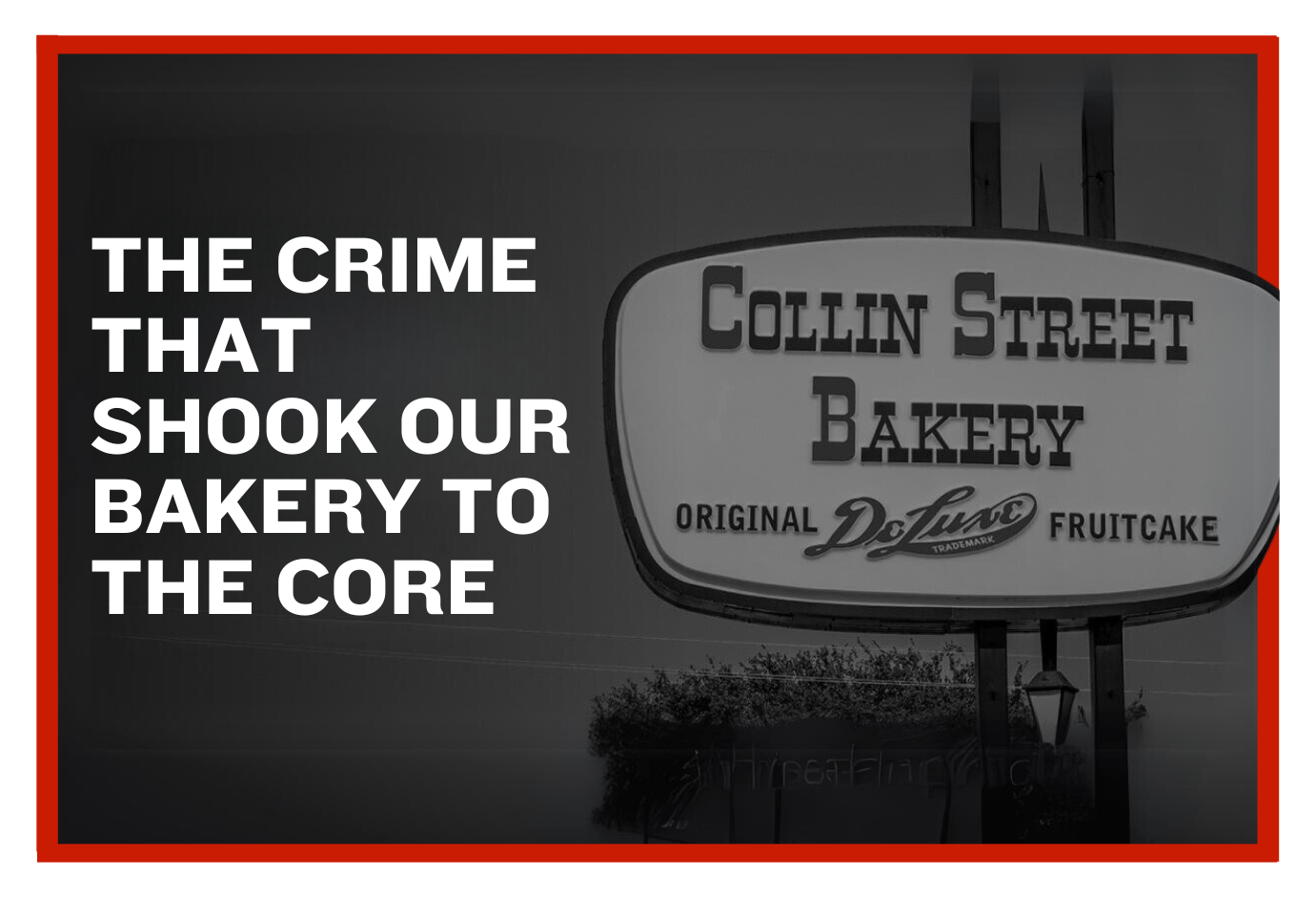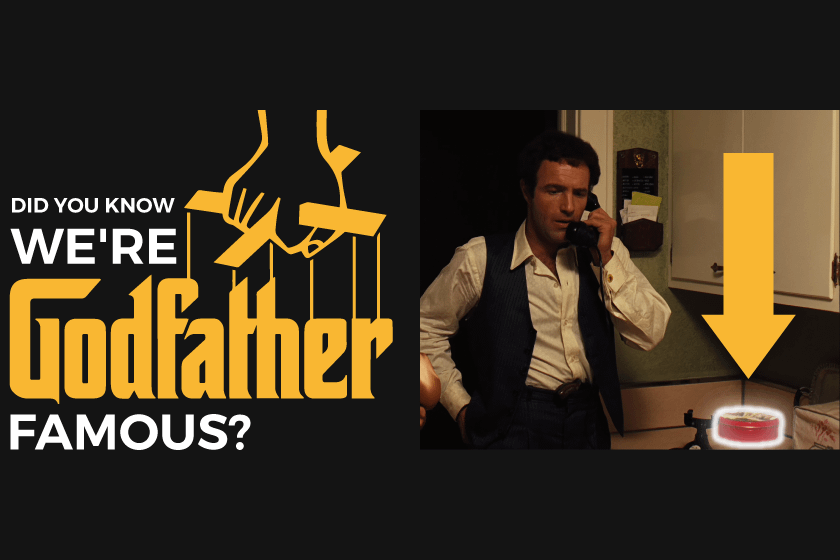The White-Collar Crime that Shook Our Bakery to the Core
When the citizens of Corsicana awoke on Wednesday, July 24, 2013, there were no signs to suggest it would be anything more than a routine summer day. It was 95 degrees and swelteringly hot, as the weatherman had predicted. All across town, sounds of ordinary life drifted upwards from the town’s patchwork quilt of sprawling neighborhoods. Kids played in sprinklers, men mowed their lawns, women watered their plants, and cicadas droned incessantly in the background. It was a beautiful yet unremarkable day…until a small parade of unmarked, gray sedans turned down West Third Avenue. Their destination, only clear in retrospect, was the home of Kay and Sandy Jenkins, the comptroller at Collin Street Bakery.
 President & CEO Bob McNutt outside Collin Street Bakery's Corporate Offices—Image Source: Texas Monthly, Wynn Myers
President & CEO Bob McNutt outside Collin Street Bakery's Corporate Offices—Image Source: Texas Monthly, Wynn Myers
For years, this part of our company’s history has been a point of internal debate and controversy. While some have advocated sharing our side of the story, others preferred to bury it in a time capsule, hoping it never resurfaced. Understandably, the story about our former accountant’s nine-year-long fraud is salacious and entertaining—true-crime fodder at its best. Had our bakery not been the victim, it surely would have inspired water-cooler discussions. Instead, the reality of this betrayal cast long, dark shadows over our company.
Looking at this crime through a lens focused on the accused, embezzlement is a crime of greed and desire. Shift that focus to view the victims of embezzlement, and the opinions are not much kinder—gullible, naive, and foolish are words typically ascribed to the wronged. Lacking in both these top-level assessments of embezzlement is empathy.
Oftentimes, embezzlement is a crime committed out of a perceived sense of necessity and its continuation enabled out of a justifiable sense of trust. Think about it. Why would someone take what is not theirs? Why would you suspect a colleague? Why would someone steal from a person they respect?
At its core, embezzlement is a crime against honesty, integrity, and the almost intrinsic ethical understanding between right and wrong.
The harsh reality of embezzlement doesn't seem to inspire the public sense of empathy other victims of crimes can expect to receive. Judgment rains hard on the victim, encouraging the crime's casualties to feel as ashamed and embarrassed as the perpetrator.
”However, just as time transforms tragedy into comedy, it also transforms embarrassment into education.”
Until our recent true-crime feature on Discovery+, Collin Street Bakery has never really spoken this publicly about the embezzlement that shocked our business. The show’s positive reception has encouraged us to break our silence and contribute to the narrative to elaborate and educate. To this end, we’ve interviewed professionals specializing in the white-collar crimes of fraud and embezzlement—a Certified Internal Auditor, a Prosecutor of White-Collar Crimes, and an agent of an independent state law enforcement agency specializing in investigating white-collar crimes.
We hope this article is as enlightening and entertaining to you as these conversations were to us. We strive to share the lessons we’ve learned and the mindset we carry regarding our hope and faith in people. To set the stage, we first have to gradually work our way back in time—from when the crime became public to further back when the crime was uncovered, and even further still, to dissect the environment that made the crime possible.
The Spectacle of the Scandal
The contingency of cars crawled to a stop in front of an all-white, plantation-style home. A series of impressively thick, white pillars proudly stood at the edge of a beautiful wrap-around porch. Lush, manicured grass held in the yard’s perfectly tended gardens. Bordered by a black, wrought iron fence, the house was similar to something one might find on the cover of Southern Living magazine. For all anyone knew, this unidentified group of visitors might have easily been the HOA, coming to bestow the “Yard of the Month” title upon the Jenkins’ residence. It became clear this was not the case as each car’s occupants stepped out in a uniform of khaki pants, blue shirts, and firearm-equipt utility belts.
Rapping on the front door, these FBI agents knew neither Sandy nor Kay was home. The agency had been watching the couple's movements and had sound reason to believe both were in Austin. The manor’s lord and lady’s absence did not deter the agents, who forcibly entered the premises. Disappearing inside for a while, the agents gradually emerged, each carrying armfuls of luxury goods. After carefully depositing their loads into the parked convoy of cars, they walked back inside to retrieve more. Like a line of ants dutifully marching between fallen crumb and colony, the small contingency of agents worked diligently at emptying the house of expensive merchandise—bundles of furs, cases of wine, and designer luggage. Tow trucks carted away luxury car after luxury car—a Mercedes, a Lexus, a Denali, a BMW.
 FBI Agents emptying Sandy & Kay Jenkins house of evidence on July 24, 2013—Image Source: Corsicana Daily Sun
FBI Agents emptying Sandy & Kay Jenkins house of evidence on July 24, 2013—Image Source: Corsicana Daily Sun
Despite their unadvertised appearance, the news of the FBI’s presence at the Jenkins property spread quickly through the tiny community. Neighbors and local residents staked out spots up and down the street to observe the informal parade.
For those already at work or somehow unable to personally attend the spectacle, phone trees had been initiated to spread the word. “Did you hear? Sandy Jenkins had been stealing from Collin Street Bakery!” The replies were always filled with exclamations of shock and awe, followed quickly by probing questions. “How long had he been taking money? How much did he steal? When did the bakery discover the theft?” It was the most exciting event to happen in Corsicana in quite some time, and the town was buzzing with enthusiasm.
Just a few miles away, the atmosphere at Collin Street Bakery was somber. Still reeling from the fraud uncovered just a month prior, bakery leadership was trying to logistically, emotionally, and financially grapple with the reality of the situation. With the Jenkins’ home being seized, the veil of secrecy over the scandal had been stripped away. People were talking. Judgments were being cast.
“How could they not know what was happening in their own company?”
You might be asking yourself the same question, but it's more complicated than it sounds—don't worry, we'll walk you through the whole thing...
 Sandy Jenkins arrest intake photos—Image Source: Discovery+
Sandy Jenkins arrest intake photos—Image Source: Discovery+
The Crime Uncovered
Sandy Jenkins was hired as the Bakery’s accountant in 1998. In the summer of 2013, he’d just passed his fifteen-year work anniversary. Unbeknownst to him, he was not destined to celebrate his sixteenth. In late June of that year, Sandy had been released from his position at the bakery under fairly concrete suspicions of embezzlement. A new addition to the accounting department had unearthed a series of confusing bank statements and, after further review, brought her suspicions to the bakery’s leadership. The original discrepancy in question encompassed seven transactions totaling around $280,000. A significant chunk of change—significant enough to be reported—but a mere drop in the bucket compared to the flood of fraud yet to be uncovered.
When Sandy was confronted, he didn’t even try to deny it. He couldn’t because, as he himself put it, “I write the checks for the bakery.” There was a solid paper trail of evidence linking him to the theft. It would only be a matter of time before more questionable expenses would be discovered. In a last-ditch effort to evade justice, Sandy spent the next three weeks bopping aimlessly between his various ill-acquired estates in Santa Fe and his daughter’s estate in Austin, rendering him absent for the FBI’s initial visit. Before departing Corsicana, he’d swung by his house and stuffed insulated freezer bags with loose cash, jewelry, watches, and other valuables. As he fled, he attempted to squirrel them away in various hiding places before finally giving up and hurling the rest into a nearby lake.
The intention behind these actions is as unclear today as it was back then. Whether he was trying to minimize the evidence of his theft or create a post-trial financial nest egg, we can’t say. Either way, many of these items would eventually be recovered and returned to the FBI by unsuspecting park-goers and local law enforcement officials.
In early August of 2013, both Sandy and Kay Jenkins returned to their Corsicana residence. The door locks had been changed, but the couple found a way in and tried to lay low. Not long after, the FBI once again knocked on the Jenkins’ door, and Sandy was taken into custody, indicted on counts of mail fraud and money laundering. Kay maintained her innocence, pleading ignorance of her husband's actions. Less than a year later, in March of 2014, she was indicted on similar charges.
 Image Source: Discovery+
Image Source: Discovery+
Distinguishing Between the Crime & the Cover-Up
To get the full picture, it’s important to understand the various charges involved. Sandy Jenkins was charged with ten counts of mail fraud and three counts of money laundering. Sandy and his wife, Kay, were charged with one count of conspiracy to commit money laundering, six counts of money laundering, six counts of aiding and abetting, and two counts of making a false statement to a financial institution. Let’s break that down:
- Mail fraud occurs when an individual or individuals intend to defraud another individual or an institution using the mail.
- Money laundering entails the concealment of illegal sources of income by passing it through a series of transactions to help the money appear “clean”—this is sometimes called “money washing.”
- Aiding and abetting is the assistance of another person in the commencement of a crime.
- False statements are untrue or “less than true” statements. In this case, false statements were made to deceive a bank or financial institution into providing a favorable position to the person making the statement.
Note, the term “embezzlement” is not listed above. That’s because embezzlement is a broader, overarching term that succinctly encompasses all the above-listed crimes. It is defined as “the misappropriation of money entrusted to one’s care.” But, where does fraud fit into this definition? For this answer, we spoke with Special Agent Mark Drummond from the Oklahoma State Bureau of Investigation. With twenty years of white-collar corruption experience, Mark could speak with authority.
“Embezzlement is a type of fraud scheme. The fraud could be all the mechanisms that are put in place to conceal the embezzlement.” Elaborating further, Mark states, “Most financial crimes are covered under embezzlement, [the] obtaining money by false pretenses. The embezzlement itself would be the act. Cover[ing] up that embezzlement would be the fraud.”

Image Source: Discovery+
A Public Misperception of Embezzlement
When we began our research into the subject of white-collar crime, we expected to uncover tantalizing tales of insatiable greed and bloated egos–like Bernie Madoff’s infamous Ponzi Scheme or the film-worthy fraud committed by Mark Whitacre from the Archer Daniels Midland Company. In reality, these stories are so sensational and newsworthy simply because embezzlements of this size are extremely rare.
Embezzlement, at a smaller scale, is actually rather common. In the annual Marquet Report on Embezzlement, 554 embezzlement cases were committed in 2013 in the United States—a nearly five percent increase from 2012 and a shockingly large statistic, given the lack of media coverage. But, the over-dramatization of cases like the Madoff/Whitacre scandals has produced a three-pronged effect regarding the perception of embezzlement and its victims. The public at large has 1) a falsely deflated sense of how frequently embezzlement occurs, 2) a falsely inflated sense of understanding regarding an embezzler’s motives, and 3) a falsely confident understanding of how much blame falls on the victim.
“A lot of times people will just fall into the sin of embezzlement,” commented Phil Stambeck. Phil is a former white-collar prosecutor in the state of Oklahoma. Having spent ten years as the Head of the White-Collar Prosecution Unit in the Oklahoma County District Attorney’s Office, he’s an expert in embezzlement and fraud cases.
“I think it's just a normal human being that finds themselves in a situation in which they have an opportunity and they succumb to greed. That's it. Many of them think, ‘I am going to pay this back. I'm not a criminal.'”
This opinion is statistically backed. In a 2018 case study performed by the Association of Certified Fraud Examiners, it was determined “most occupational fraud perpetrators are first-time offenders with clean employment histories. Approximately 86% had never been punished or terminated for fraud-related conduct by previous employers.” That means, picking out a potential embezzler, based on a history of previous criminal activity, is virtually impossible.
To make things more complicated, embezzlement is a crime often committed out of either a real or perceived sense of necessity—to pay for a necessary medical procedure, tuition, rent, or food. Therefore, to the embezzler, the end could theoretically justify the means. It’s sort of like the morally complex question, “Would you steal a loaf of bread to feed your family?”
To be clear, we are not advocating thievery, whatever the rationale. We are advocating for a reflection on what could be a complex situation fueled by human emotions. Unfortunately, sometimes, life isn’t as cut and dried as we’d like. Other times, it’s a little more straightforward—we use ourselves as an example.
 Sandy (right) and his wife Kay (left) on a private jet purchased with funds stollen from Collin Street Bakery.
Sandy (right) and his wife Kay (left) on a private jet purchased with funds stollen from Collin Street Bakery.
Why Suspect Someone You Trust?
Embezzlement is a crime against trust. As Phil put it, “In embezzlement, somebody has actually been lawfully entrusted with the money. And then in an unlawful manner, takes it.” So, this begs the question: why would you suspect someone you trust when funds go missing, or numbers don’t add up? The simple answer is you wouldn’t. And we didn’t.
Everyone in town had witnessed Sandy’s sudden windfall of wealth. How the average bakery comptroller had seemingly transformed overnight into a well-to-do millionaire was anyone’s guess. Though shocking, his volunteered explanations for this change in fortune always seemed adequate—he’d inherited the money. He’d acquired some contract work. He had generous family members with fancy connections. Plus, Sandy was a really nice guy. An unassuming, quiet, trustworthy man—why should anyone doubt his word?
In Phil’s experience, this has always been the case.“It's the little ol' lady that brings donuts or home-baked goods to the office. It's the person that will remember your birthday. It's individuals that you think are super nice.” In his words, when the crime is discovered, “Not only are the employers shocked, but friends or associates of the individual, are also shocked because this is someone that they would never suspect.”
Part of this innate trust is attributed to human nature, but part can also be attributed to Texas culture. Nestled in the heart of East Texas, Corsicana is the home of Collin Street Bakery and the epitome of a picturesque American small town. Neighbors wave as they pass one another driving, children still say “ma’am” and “sir,” and a man’s word is as good as gold. Handshake deals are still considered as solid as a contract, and if a contract needs writing, it’s not done in a lawyer's office but on the hood of an old Ford pickup.
Corsicana is just a trusting community filled with hard-working, honest folks. What some might call naivety, we call faith—faith that your neighbor does unto you what you’d do unto them. We had to learn that not everyone is worthy of this innate trust. We don’t regret trusting Sandy, but it has led to us modifying our credo—start with trust and then double-check.
After learning more about embezzlement, what are the takeaways? The lesson is threefold:
- Embezzlement is a more common crime than we are led to believe.
- Most often, the motivating factor is not greed but need or a perceived sense of need.
- Victims of embezzlement aren’t bad business people—just a tad too trusting.
Unfortunately, not all these tenants apply to our scenario. But they are things to remember when other embezzlement stories are advertised. Sandy Jenkins was motivated by greed from the outset, but his reasons placed him in the minority of perpetrators. While this is only a minorly comforting notion, in stories like ours, you have to look for a silver lining anywhere you can.
 Image Source: Discovery+
Image Source: Discovery+
How Sandy Started Stealing
Before he entered into the world of crime, Sandy hadn’t done poorly for himself. He was a relatively successful professional with a loving wife and a historic home. He didn’t have a new car nor this season's must-have labels, but he was far from indigent. He was an average hard-working guy who aspired to acquire what he desired. But, the things he desired were disproportionate to the professional life he’d created.
This realization had slowly festered as he bemoaned the length of time it took to save. One day, frustrated at watching his savings account slowly fill, he dipped into the bakery’s petty cash. When the missing money went unnoticed, he took it a step further, writing himself a check to cover the cost of his most recent credit card expense—a down payment on a new Lexus. Mentally casting himself as a kind of Robin Hood, Sandy had stolen from the rich and given to the poor—except, in this case, before his theft, he considered the “poor” to be himself. It was a weak rationalization and the exact opposite of altruism.
As much as he’d attempted to justify his actions, ultimately, he had stolen from a company he loved and people he respected. Sandy adored fruitcakes and held Bob McNutt, Collin Street Bakery’s President & CEO, in high regard. As Texas Monthly's Just Desserts article put it, “Bob was wealthy, but he didn’t flaunt it. His shirts were nice but not flashy. He gave to charity and didn’t brag around the office if he traveled on a private jet. He had a dry, endearing wit… [Sandy and Bob] attended the same church.”
“He shoved those guilty feelings aside because it was just a one-time thing. He wasn’t planning on doing it again. He’d gotten his car, his token of hard work. He was going back to being an honest, ordinary guy. He was not a crook… but it was just so easy.”
Sandy didn’t write himself another check till some time later, but once he knew how simple it was, the lure of the company checkbook called like a siren’s song. One day, it was like a switch had flipped, and his hesitation about writing fraudulent checks vanished. The slippery slope had begun. Sandy was all in.
“[Embezzlers think] I'm only doing this as a short-term thing,” commented former White-Collar Prosecutor Phil Stambeck. “Then they find out that it's so easily done, and they just get into a habit of doing it.” Looks like Phil clocked our situation perfectly.
How the Embezzlement Lasted for Nine Years
After Jenkins was arrested, our bakery dove headfirst into stacks of records reviewing hundreds of thousands of pages of financial documents. In retrospect, it was clear something was afoot but, in hindsight, isn’t almost everything? “Of course, we didn’t spend that much in tins that year. No way we ordered that much fruit—this explains our losses…in part.” But, only in part. This is a critical part of our side of the story and an important reason why it took nine years to detect the fraud.
You see, when fledgling companies see fluctuations in growth, they panic. When 117-year-old companies see fluctuations in growth, they view it as the ebbs and flows associated with the tides of business. Some years are high and some years are low. Now for our bakery, we’d been experiencing a low. This low was attributed to customers' changing views associated with our chief product: fruitcake.
Vice President of Public Relations, Hayden Crawford explains it best. “The [negative] perception began to creep in, in the mid-'70s. It was just a change in the lifestyle of most Americans, to what they considered to be more healthy… So in the '70s, we began to struggle with our perception in the marketplace.”
President and CEO of Collin Street Bakery, Bob McNutt, adds, “Our struggles continued in the 1980s…[when] Johnny Carson led [the] denigration of fruitcake. It became popular to badmouth fruitcake, and people would even run ads disparaging [it]. That led to people who'd never even tried it to have a predetermined, unfavorable opinion about fruitcake.”
Essentially, the fruitcake industry was going through a rough patch. And from a thirty thousand foot view of our finances, the books backed that assessment. However, the company was determined to turn perception around. Marketing efforts were significantly increased to reinvigorate the brand—both the volume of mailers and the advertising budget had been upped. Profits might have been down, but these increased expenses were supposed to turn the tides.
Nobody knew this plan better than the accounting department—specifically, Sandy Jenkins. It was the perfect environment for a little book baking. Who’s to say the continued decrease in profits wasn’t because the marketing had failed? In fact, the more marketing dollars spent, the more Sandy could fudge the numbers under the guise that these were legitimate promotional expenses, not money going into his own pockets. From the leadership’s perspective, it would look like the bakery was spinning its wheels, working very hard to get nowhere—when in fact, the marketing had worked, it just wasn't showing.
Hayden would tell Bob. “It doesn’t make sense. We’re doing something wrong. We reviewed our expenses, audited our payroll. We just can’t seem to pinpoint the problem.” Fortunately for Sandy, the audit requests always came through him, enabling him to deftly manipulate reports provided to the leadership.
This reporting structure enabled Sandy to continue his con for nine years, a statistical outlier by embezzlement standards. Again referencing the 2018 case study performed by the Association of Certified Fraud Examiners, “the typical occupational fraud scheme lasts fourteen months before it is detected.” Month after month, the bakery reported losses, convinced there had to be something wrong, but unable to locate the cause. It wasn’t until that fateful Thursday in the summer of 2013, that Sandy’s side-hustle finally hit the skids and the truth came out.
Trial & Sentencing
When Sandy finally went to trial and the complete list of charges was laid bare, the enormity of the crime was heartstopping. Listening to hours of testimony detailing Sandy’s and Kay’s lavish lifestyle was a spectacle any gossipy housewife would have given her eye teeth to hear firsthand. Evidence produced during sentencing by Assistant U.S. Attorney J. Nicholas Bunch regarding the Jenkins list of expenses was scandalous and flooring. The couple took more than 223 trips on their private jets to exclusive locations including Santa Fe, Aspen, and Napa. The total cost of their travels exceeded $3.3 million.
Additional evidence produced by the FBI indicated that when the couple wasn’t extensively traveling, they enjoyed a lavish, opulent lifestyle close to home. “Jenkins purchased 38 vehicles over the course of the scheme, including many Lexus automobiles, a Mercedes Benz, a Bentley, and a Porsche… Jenkins spent over $11 million on a Black American Express card alone—roughly $98,000 per month over the course of the scheme—for a couple that had a legitimate income, through the Bakery, of approximately $50,000 per year. The evidence at sentencing also established that a significant portion of stolen funds (approximately $1.2 million) [was] spent at Neiman Marcus at Northpark in Dallas… The government further proffered evidence at sentencing that the Jenkins stopped shopping at Neiman Marcus when Neiman’s ran out of things to sell them.”
Ultimately, Sandy was sentenced to ten years in federal prison after he pleaded guilty in May 2014 to one count of mail fraud, one count of conspiracy to commit money laundering, and one count of making a false statement to a financial institution. Sandy’s wife, Kay, was sentenced to five years probation and 100 hours of community service in May 2015 after she pleaded guilty to one count of conspiracy to commit money laundering.
The Total Tally
In total, Sandy had embezzled roughly $16.7 million—$114,342 in cash and $16,649,786 in checks, on 900 separate occasions—a crippling total that might have taken down a younger company. Some restitution was made in the way of a massive estate sale at the Jenkins property, resulting in the return of roughly $4 million in stolen funds. The rest was never recovered. But, our bakery was determined to learn from this experience and survive.
“The company really set itself up for an embezzlement,” commented Phil Stambeck. Remember, Phil is the former white-collar prosecutor we mentioned above. “[The company] committed the cardinal sin of having one person that approved the claims and also signed the checks.” But, not anymore, Phil. Not anymore! Over the years, we’ve implemented tighter financial measures to ensure reporting transparency and honesty. Regular internal audits are conducted to ensure records are accurate. And, channels for interdepartmental communication have been created, to encourage openness, clarity, and visibility.
Scars from the embezzlement are still visible. You can hear the hurt in the way people speak. But, there’s an undeniable undercurrent of hope still surging throughout the office. “Collin Street Bakery is the ultimate comeback kid,” commented Thomas McNutt, Collin Street Bakery Executive Vice President. “Of course, we still remember the horrible, awful theft that happened from somebody who the business loved and trusted. But, once the business was financially stabilized from the embezzlement, we started experimenting with a lot of different initiatives in e-commerce and wholesale. We partnered with Amazon Prime, brought on a bunch of innovative team members, and really worked to get our work culture to where it needed to be.”
Not only has our bakery diligently worked to modernize our business and build a supportive, communicative, and honest culture, but, public perception of fruitcake has finally turned for the better. “In the past five or six years, we’ve seen a change in attitude of our potential customers,” said Hayden Crawford, Collin Street Bakery’s VP of Public Relations. “Now, people are looking at fruitcake and Collin Street Bakery as something intriguing, a throwback, a harkening back to the past, and something to be cherished and to enjoy. So, we've turned the corner.”
Trust, But Verify
We all consider ourselves to be adept, intuitive people, intelligent enough to detect a criminal in our midst. But, if the rise in popularity of the true-crime genre has proven anything, it’s that anyone can be taken advantage of. Admittedly, this sounds like a cynical mindset—a change in thinking evolutionary to those having been caught holding the short end of the stick. No one could blame us for learning their lessons. Yet, despite our hard knocks, we haven’t allowed ourselves to become jaded. We still think most people are honest and good. The additional leg work we perform isn’t to catch a crook but to continuously affirm our hope and faith in society. People are trustworthy—we know. We’ve checked the books.
Phil Stambeck put it best. “You want to trust every one of your employees, you want to treat them like family, but you also want to verify and that's for your own protection. And if you don't do that, then you run the risk of being a victim.”
Taste the Cake that Fueled the Fraud
We bet you didn’t know there was so much money in the fruitcake business. One bite of our world-famous fruitcake will have you singing a different song. Try for yourself the fruitcake that fueled our small-town scandal. Order our DeLuxe® Fruitcake today!









Leave a comment
This site is protected by hCaptcha and the hCaptcha Privacy Policy and Terms of Service apply.